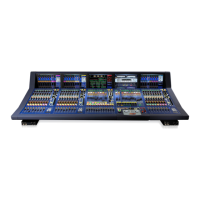Communications 207
XL8 Control Centre
Operator Manual
Solo in place (SIP)
Operating a solo button cuts all channels from the main mix except soloed ones; this is
called solo in place (SIP). SIP allows you to check the contribution from soloed
channels at the actual levels they occur in the mix, that is, taking into account the main
fader setting. If solo buttons cut the main output (main mix) they must only be used in
rehearsals. Sometimes, SIP selection buttons are disabled during recording (solo safe)
or revert to AFL (only affects monitor outputs). See “Solo system” on page 111.
Communications
Refer to “Comms” on page 106.
Internal talk mic
The control surface has an internal talk mic that allows you to talk to external locations.
To select the internal talk mic
1 Press the internal TALK switch in the talk mic section; see “talk mic” on
page 107.
2 Select the source, A or B, by pressing the talk back A or B switch in the
source a or b sections; see “source and output (a and b)” on page 113.
External talkback
As well as being able to talk to external locations you can also be talked to from an
external location. The external talkback input is a mic/line input at the stage end of the
system that, when enabled in the monitor section (see “source and output (a and b)” on
page 113), can mix onto the local monitor outputs.
To select external talkback
1 Press the external TALK switch in the talk mic section; see “talk mic” on
page 107.
2 Select the external source, A or B, by pressing the EXT switch in the appropriate
source a or b section; see “source and output (a and b)” on page 113.
Talk groups
A talk group is a control that, when operated, activates the internal talk control on all
associated buses. There are eight talk group buttons in the comms section of the
output bay (see “talk osc/routing” on page 109) that allow you to talk to or send test
signals to any bus on the control centre and, therefore, any control centre output. This
can be to a single bus or to many buses simultaneously by using the four fixed
association talk buttons or the four user-assignable talk group buttons, respectively.
The user-definable buttons can be set up (via control surface or GUI) to contain any
combination of aux, audio sub-group, mix or master buses and could be used, for
example, for grouping announcements or for talking to groups of artists in a monitor
mix.

